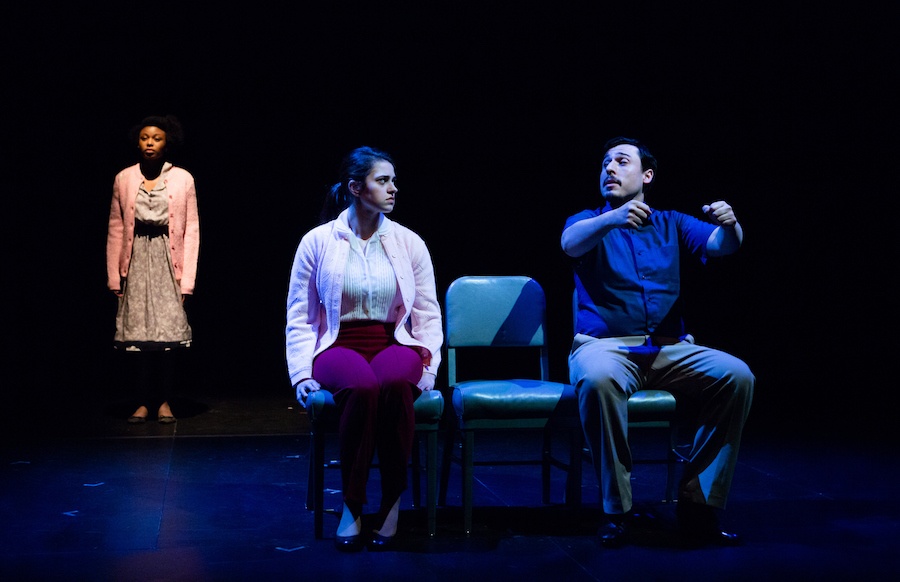
Southern Connecticut State University | Theater | Arts, Culture & Community
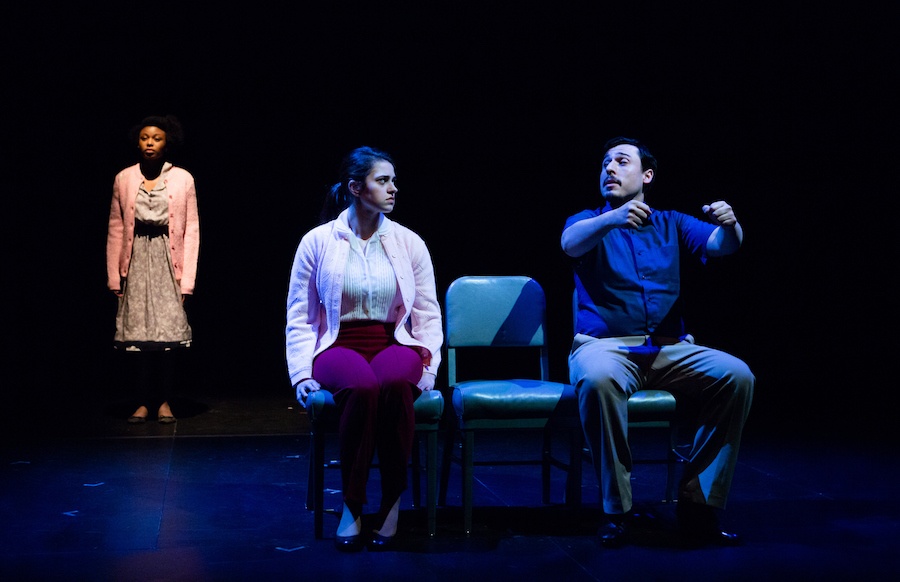
| From left: Nomble Tanner, Julia Raucci, and Jason Carubia in How I Learned To Drive. Isabel Chenoweth Photos. |
Li’l Bit is posing for her Uncle Peck. Back arched. Breasts straining against her white blouse. Red hair cascades down her shoulders and onto the top of her back. Peck turns the radio dial—it’s a new tune, fuzzy and slow—and has her sway to the music. Shoulders hunch and roll. A button comes undone somewhere in there. There’s a cream-colored, fleshy recess above her breasts.
She is eleven years old. Her eyes are watery black pits. The camera clicks.
"There’s nothing wrong with what we’re doing here,” Peck tells her.
That’s the tension in Paula Vogel’s How I Learned To Drive, running at Southern Connecticut State University’s (SCSU) Kendall Drama Lab Tuesday through Saturday evening and Sunday afternoon. Written by Vogel and directed by Drama Department Chair Kaia Monroe Rarick, the play puts SCSU students right at the heart of #MeToo, exploring specifically the self-blame, silence, and complicity of family members in incest and pedophilia. Tickets and more information are available here.
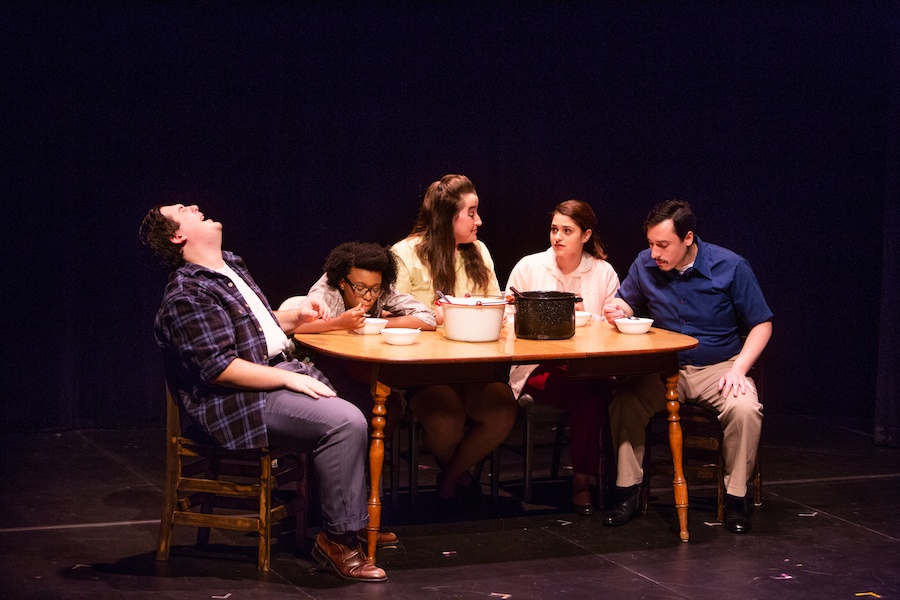
First published in 1997, How I Learned To Drive tells the story of Li’l Bit (a doe-eyed Julia Raucci), a teenager from suburban, working-class Maryland who is learning to drive from her Uncle Peck (Jason Carubia) in the late 1960s. Since Li’l Bit—so called for the little bit of genitalia her mother saw when she was born—doesn’t have a father figure, she turns to Peck to fill in the gaps that her mother cannot.
And for a while, he does. There’s Uncle Peck at the dinner table, urging Li’l bit not to get so worked up when her grandparents comment on her growing chest. Peck washing dishes after the family’s Christmas meal, wowing Li’l Bit as he breaks with gender stereotypes to scrub a pan clean. Peck reassuring his nephew that there’s nothing wrong with crying. Peck at the lip of the stage, vowing that he has loved Li’l Bit since the moment he could hold her as a baby in one big, outstretched hand.
But there’s also Peck rubbing Li’l Bit in the front seat of his car, as she grips the steering wheel and he steers her hips. Peck, who sees in this girl’s body so much of his 1965 Chevrolet, which he commands at full gear on the clover-scented backroads of Maryland. Peck thumbing her nipples like radio dials, praising them as “celestial orbs” as Li’l Bit leaves her body for what isn’t the first time, and won’t be the last.
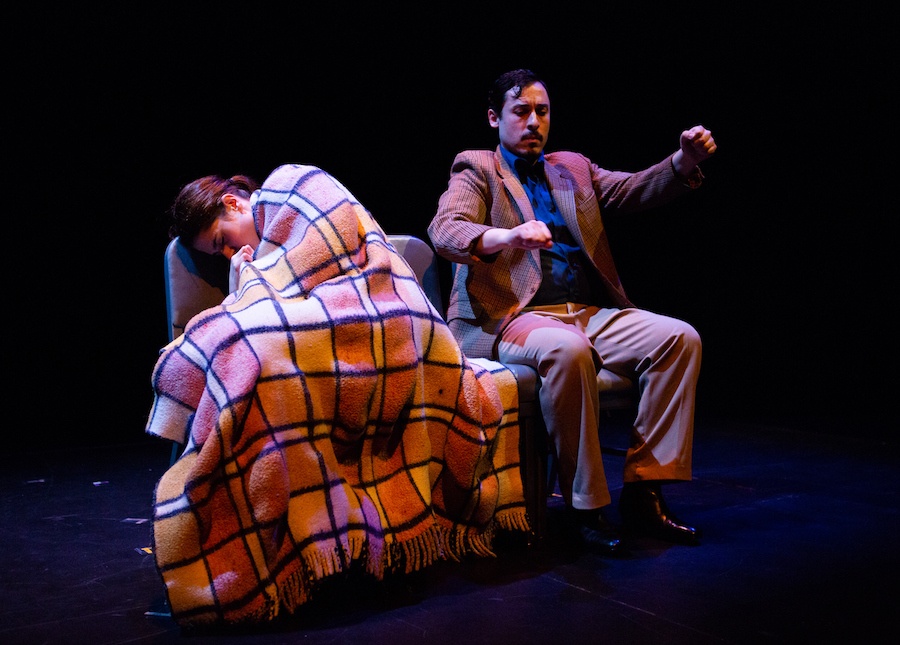
As the play hurtles forward, the car is a powerful metaphor: we accelerate and go backwards, get carsick and bounce back and get carsick again. There are times when we are going so fast we can only catch glimpses in the rearview mirror—of a childhood snatched from Li’l Bit, of her own mother’s depression and fear of failure, of Uncle Peck’s alcoholism and post-WWII PTSD, for which there is no terminology in the 1960s and 70s.
In a particularly nimble production move, projection, scenic, and lighting designer Douglas Macur has staged the show like one big driver’s education film, the screen behind actors coming to life with grainy, 1950s-esque film, text and voiceover work. It fills the small blackbox with its sound, soaking the audience in this girl's upside-down world. True to driver's ed—and the script—it's not without humor, making the work all the harder to stomach.
Monroe Rarick first read the play as a college student, where she picked it up for pleasure as part of a new plays subscription her mother had given her. She recalled being “blown away” by the work, moved and astounded that Vogel had given actors a platform to speak about pedophilia and incest in the 1990s, when those topics were still largely (as they continue to be) verboten. After reading it she followed the work of Mark Brokaw, who first directed the play at New York’s Vineyard Theater in March of 1997. So when SCSU was choosing this year’s lineup, it jumped to the forefront her mind.
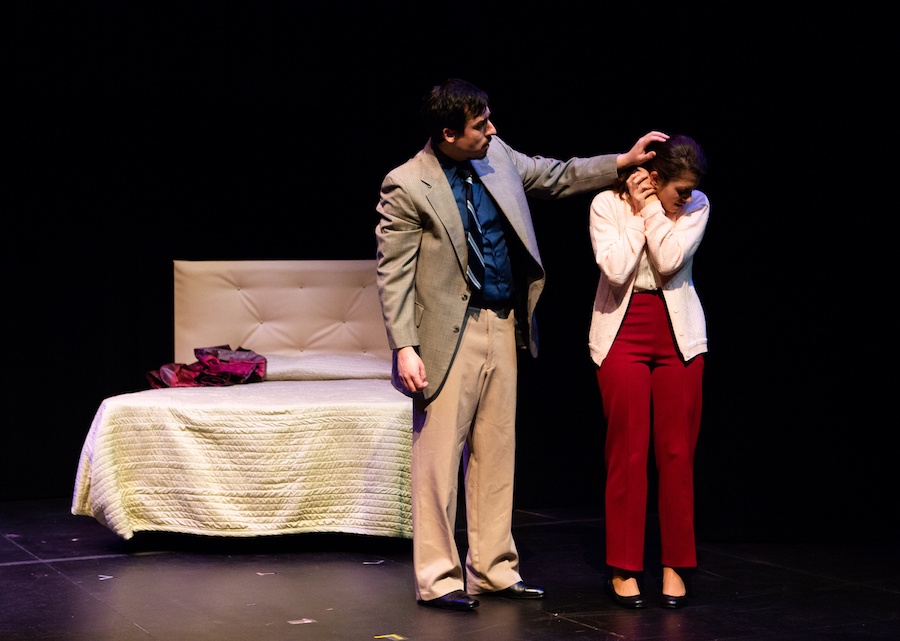
“I thought, ‘we’ve gotta do something that addresses the cultural moment we’re in,’” she said at a final tech rehearsal Monday night. “I wanted to do this because of Larry Nassar, because of #MeToo, because of Harvey Weinstein.”
The result is harrowing, hard-to-watch account that feels deeply true to real life. When Peck tells a 13-year-old Li’l Bit “I love you,” her eyes soften immediately, and we are reminded of every uncle that has leaned in a little too closely and said some version of same thing, pausing to push a hair aside or squeeze us close to the ribcage. When he reassures her that there’s nothing wrong with what they’re doing—he isn’t her blood uncle after all, he says—we feel those in-between spaces of childhood, where something didn’t feel right but we couldn’t articulate why.
A small but mighty cast—just five members, three of whom shape shift into multiple roles—brings the show to life in vivid color, turning skin to gooseflesh with each gear shift, each hard push on the gas pedal that is this play. As Li’l Bit, Raucci has made herself immensely vulnerable, a constant, humming discomfort running through her and into the audience like an electric shock. Her face and eyes, often wet and wide as saucers, are immensely expressive, conveying half of her lines before she even speaks them into being. She is firm when the script calls for it, but mostly lives in her character’s in-between, a slick layer of fear under every move she makes.
Around her, students Anna Huether, Nomble Tanner and Jack Storm are the architects of Li’l Bit’s universe, showing the audience the life she is trying so desperately to escape. Huether gives an especially brilliant performance as she narrates “a woman’s guide to drinking,” progressively sloshed in the foreground as Peck pushes martinis on his underage niece at a restaurant. And the three are chilling as a sort of Greek Chorus, haunting the stage as they chronicle how much of Peck stays with Li’l Bit, even after she is able to physically escape them.

So too a smooth-talking and particularly unctuous Carubia as Uncle Peck, fitting so well into what theater critic Ben Brantley once called “a pedophile even a mother could love.” There’s Uncle Peck, the Southern gentleman and endearing black sheep of the family, just trying to do right by himself and his kin. Or Peck the pedophile with a hidden darkroom, priming his niece for photoshoots in Playboy. Carubia gives a terrifying, devastating performance that is wise beyond his years, less the jumper cable, and more the spark that comes flying off of it. In character, he is so convincing you have to shake it out after the play.
Together, cast members play it as an unsettling testament to how little has changed between Li’l Bit’s childhood and our own #MeToo moment. Twenty years after the play won a Pulitzer Prize for drama and decades after Li’l Bit’s storyline has come to a close, the play feels like it could have been written for 2018, with updated auto models and fewer day dresses and pencil skirts. Vogel is not quiet about the complicity of family members, and cast members seize on her writing, stressing lines like “if something happens, I’m holding you accountable!” and mentions of Li’l Bit—not Peck—as a shrewd, sly siren, wrapping men around her finger as she busts out of her training bra.
“If we are to stop the cycle of sexual abuse within families and prevent pedophiles from becoming prolific, we must expose the sexual abuse of children—like diseased flesh—to the air, examine it, and talk about it,” Monroe Rarick writes in her director’s note for the play. “We must arm little girls as well as little boys, with agency. They must have complete ownership over their bodies. We must teach them that their right to psychical privacy takes precedence over adult authority.”
As SCSU opens the show during the school’s annual Social Justice Month, cast and crew are also responding to the material—blessedly without overwrought trigger warnings. With Monroe Rarick, the crew has mounted an interactive storyboard outside the theater, where audience members can write or draw their responses to the show on post-it notes. Directly following Thursday’s performance, Publicity Coordinator Molly Flanagan will hold a symposium in the theater with SCSU faculty working on childhood trauma, sexual abuse, and Paula Vogel's work.
Paula Vogel’s How I Learned To Drive runs at the Kendall Drama Lab in the Lyman Center for the Performing Arts Nov. 27-Dec. 2. Tuesday through Saturday, performances are held at 8 p.m. Sunday’s performance will be held at 2 p.m. Tickets are available here.

